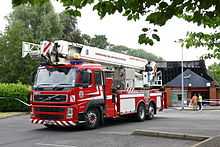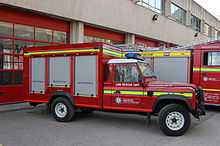Fire appliances in the United Kingdom


Fire appliances (also known as fire engines or fire tenders) used by the fire service in the United Kingdom fit into several distinct categories and perform a wide range of general and specialised roles.
Modern day fire appliances are technologically-advanced machines compared to the steam-powered ones of a hundred years ago. The modern appliance is capable of carrying a multitude of equipment and firefighting media (such as water and foam) to deal with different types of emergencies ranging from fires, rescues, vehicle extrication, floods, salvage, casualty and trauma care; not just pumping water.
The design and size of a fire appliance depends very much upon the role it is expected to perform. In general, most fire and rescue services utilise a standardised range of vehicles and equipment. However, airport fire services tend to use much larger and heavier appliances than those typically deployed by public fire services.
Common UK fire appliance manufacturers and suppliers include Dennis, Scania, Volvo, HCB Angus, JDC, EmergencyOne and Carmichael. Most front line fire appliances in the UK are marked in high conspicuity red and yellow battenburg markings, and are fitted with blue lights and sirens. Many appliances have roller shutter doors revealing compartments housing various items of equipment.
Public fire and rescue services
Public fire and rescue services are those operated by fire and rescue authorities, and funded by council tax. Most fire appliances used by them are referred to as "domestic" type appliances to differentiate them from larger airport crash tenders. They are normally based on truck chassis and weigh over 12 tonnes, meaning they require an LGV license to be driven. Some brigades use slightly smaller appliances based on GVW of 7.5 tonnes, which do not require an LGV license. They are common in rural brigades where narrow lanes and rough terrain would be difficult for a larger fire engine to negotiate.
Pump Rescue Ladder / Rescue Ladder / Pump Ladder / Water Rescue Tender

The most common front line appliance deployed to all emergency calls goes by a variety of names, including Rescue Ladder, Pump Ladder, Water Rescue Tender, or slight variations on those names.
It is a general purpose unit capable of carrying and pumping water, carrying rescue and cutting equipment to deal with road traffic accidents and other rescue operations, a large ladder (for example 13.5m) and several smaller ladders and roof ladders.
The appliance also carries breathing apparatus, lighting, tools, trauma care packs, water rescue gear, lines (ropes), hoses, and possibly chemical protection suits and foam. The vehicle will be crewed by four to six firefighters.
Water Ladder / Water Tender
A Water Ladder or Water Tender is very similar to the aforementioned appliance, however with less emphasis on rescue gear and will usually carry a smaller ladder (for example 9m or 10.5m).
It is normally mobilised to augment and support the initial appliance or to respond to secondary, less urgent incidents. It is crewed by four to six firefighters.
Hydraulic Platform

A Hydraulic Platform (HP) is a large appliance used for effecting rescue from high-rise structures.
It is essentially a large crane fitted with a caged platform which can be hoisted to heights well over 30m in some cases. The platform may be raised to windows or balconies to rescue stranded persons.
The appliance is also capable of pumping water and as such occasionally these units are also used to direct hose reel water jets into a fire from an elevated position.
Turntable Ladder

A Turntable Ladder (TL) is similar in appearance to a HP, however with a primary difference of instead of having a caged platform the TL is simply a large telescopic ladder, which can still be used to effect rescues from tall structures and pump water.
Aerial Ladder Platform
An Aerial Ladder Platform (ALP) is designed to deploy an elevated master stream of water,or to provide a method of rescuing trapped persons, the 'knuckle' design of the arm of an ALP means that it is very manoeuvrable for rescue situations. The ALP also has a set of ladders alongside the main boom that can be used for access or escape in the case of boom failure while at height. The ALP has become the most common type of aerial appliance found in the UK since its widespread introduction in the late 1980s.
Light Four-Wheel Drive Pump

Light Four-Wheel Drive Pumps (L4P) are a smaller version of the front line fire engine. They are usually used in rural locations where they can more easily negotiate tough terrain, narrow streets or remote access to certain areas.
They ordinarily carry a condensed quota of the equipment usually found on a normal-sized fire engine.
Light Two-Wheel Drive Pumps (L2P) may also be used.
Rescue Tender
A Rescue Tender (RT) is a generic term for any fire appliance which carries out a "heavy" or "specialist" rescue role.
The equipment it carries varies depending on where it is deployed. It may carry heavy-duty cutting equipment for use at road traffic collisions or other transport incidents.
Water rescue and confined space rescue gear may also feature, as well as extensive lighting equipment and pneumatic airbags to lift heavy loads.
Operational Support Unit
.jpg)
An Operational Support Unit (OSU) is a multi-role vehicle.
The term is interchangeable with other support appliances such as HazMat and chemical support, breathing apparatus tenders, hose layers, damage control tenders or decontamination units.
An OSU carries equipment to support normal fire appliances and crews, typically at prolonged or major incidents.
Breathing Apparatus Tender
Breathing Apparatus Tenders (BAT) carry extensive stocks of spare breathing apparatus (BA) cylinders at large incidents. They replenish cylinders which may have been used by firefighters tackling a protracted blaze or dealing with Hazardous Materials.
Some BATs are also fitted with compressors which allow empty BA cylinders to be recharged on scene. Most also contain a mobile workshop so that BA sets can be repaired at the scene of incident so that they can be made available for use again at the incident within a very short space of time.
HazMat / Scientific Support Unit / Decontamination Unit
These are specialised units equipped to deal with Hazardous Materials incidents.
Decontamination Units carry specialised equipment capable of decontaminating emergency workers and/or members of the public who have come into contact with HazMats. The equipment carried is wide-ranging and highly technical in nature.
Command Unit

The advancement of technology and potential for very large-scale incidents has led to more fire services utilising or increasing their use of mobile Command Units.
A fundamental advantage of such an appliance is to accommodate the many different types of communication equipment needed at major incidents. In addition to the wide range of radio frequencies used, fire chiefs often need to communicate via landlines and send and receive information via satellite links and CCTV of the ongoing situation.
The command vehicle can essentially be used as an on-site conference centre for command personnel, mapping and planning firefighting operations and booking-in and directing crews as they arrive.
Water Carrier
Water Carriers (WrC) are tankers that are used to provide vast volumes of water to locations that may not have a nearby hydrant or open water supply. In some Fire and Rescue Services they also double as Foam Tenders.
Foam Tender
Foam Tenders (FoT) carry large amounts of foam to be used at incidents where water is ineffective or cannot be used to tackle a blaze. They may take the form of a tanker, or a lorry carrying foam packets or barrels. In some Fire and Rescue Services, Water Carriers serve as Foam Tenders, by dumping their regular load of water and replacing it with foam.
Welfare Unit / mobile canteen
At large protracted incidents firefighters may be subjected to physically arduous work in inhospitable situations such as extreme heat. As such the welfare of firefighters is taken very seriously and ability to provide refreshments to sustain hydration and energy levels is paramount. This is where a Welfare Unit is mobilised. Welfare Units are sometimes nicknamed soup dragon as a principle fayre is soup. This nickname comes from a children's TV series called The Clangers.
Fire Investigation Unit
A Fire Investigation Unit (FIU) attends fires and incidents where the cause is thought to be suspicious, and is crewed by specially-trained experts, acting in assistance to police investigations. It may take the form of a car or van.
Some brigades may also utilise specially-trained search dogs. At the scene of incidents, the dog wears specialist protective 'fire wellies' on his or her paws to guard against injuries from broken glass or hot material. The dogs can detect minute quantities of hydrocarbon accelerants within minutes. This procedure would normally take a human investigator - using specialist equipment - much longer, before samples can be taken away for scientific analysis.
New Dimension vehicles

New Dimension vehicles are large curtain-side trucks designed to be deployed at incidents involving CBRN materials or for urban search and rescue (USAR) use at the scenes of natural or large scale disasters.
They do not pump water, but instead carry vast quantities and stocks of mass decontamination equipment, scene lighting, chemical protection kits, environmental protection equipment and general purpose rescue equipment. They are always on standby to be deployed if local resources may be overwhelmed.
The New Dimension vehicles are owned by the government, rather than the fire and rescue service and are stationed at strategic locations throughout the UK.
High Volume Pumps
High Volume Pumps (HVP) are also part of the New Dimension scheme. They carry a submersible pump, supplying water from any open source to the fireground; a pump that pumps up to 8,000 litres per minute (twice as much as a standard fire engine); a hose box module; and ancillary equipment. This equipment is carried in a pod on the back of the vehicle, similar to goods on a flatbed truck. Because the vehicles are standard across the country, any HVP vehicle can carry any pod, irrespective of the Fire and Rescue Service the vehicle or pod is operated by. The pods are the same dimensions as the other New Dimension pods, so a vehicle that is utilized for HVP operations can carry an USAR pod.
They were used to great effect and in vast scale to assist operations at the Buncefield fire in Hertfordshire in 2005 and nationwide flooding in 2007.
Motorcycles

In July 2010, the Merseyside Fire and Rescue Service began a six-month trial of two fire bikes to be used to fight small fires, freeing up main appliances. Merseyside has also deployed other bikes for various uses since 2005. Several UK fire services use fire bikes not for firefighting, but as motorcycle road safety awareness tools.
Ministry of Defence Fire Services
The Defence Fire and Rescue Service and RAF Rescue & Firefighting Service operate numerous types of appliances, ranging from domestic-type tenders to airfield crash tenders, depending on the location they are serving.
Industrial and private fire and rescue services
Industrial and private fire and rescue services use several types of appliances depending on the type of cover provided. Large oil refineries may have their own on site Fire Service whom deploy large bulk foam tenders to deal with major oil fires. Domestic type fire appliances are most commonly used.
References
| Wikimedia Commons has media related to Fire engines of the United Kingdom. |
| ||||||||||||||||||||||||||